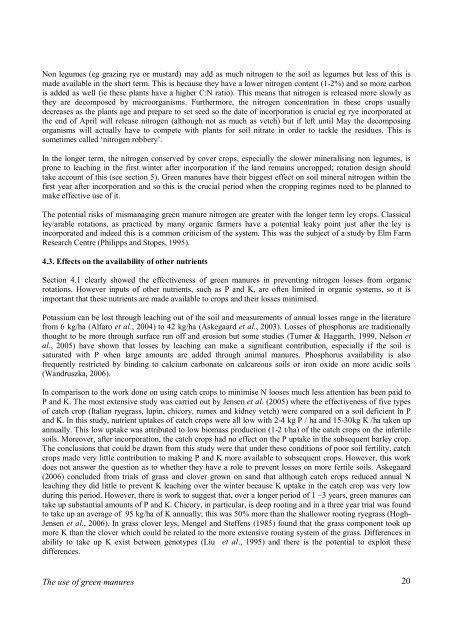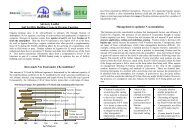Green Manures booklet - Institute of Organic Training and Advice
Green Manures booklet - Institute of Organic Training and Advice
Green Manures booklet - Institute of Organic Training and Advice
You also want an ePaper? Increase the reach of your titles
YUMPU automatically turns print PDFs into web optimized ePapers that Google loves.
Non legumes (eg grazing rye or mustard) may add as much nitrogen to the soil as legumes but less <strong>of</strong> this is<br />
made available in the short term. This is because they have a lower nitrogen content (1-2%) <strong>and</strong> so more carbon<br />
is added as well (ie these plants have a higher C:N ratio). This means that nitrogen is released more slowly as<br />
they are decomposed by microorganisms. Furthermore, the nitrogen concentration in these crops usually<br />
decreases as the plants age <strong>and</strong> prepare to set seed so the date <strong>of</strong> incorporation is crucial eg rye incorporated at<br />
the end <strong>of</strong> April will release nitrogen (although not as much as vetch) but if left until May the decomposing<br />
organisms will actually have to compete with plants for soil nitrate in order to tackle the residues. This is<br />
sometimes called ‘nitrogen robbery’.<br />
In the longer term, the nitrogen conserved by cover crops, especially the slower mineralising non legumes, is<br />
prone to leaching in the first winter after incorporation if the l<strong>and</strong> remains uncropped; rotation design should<br />
take account <strong>of</strong> this (see section 5). <strong>Green</strong> manures have their biggest effect on soil mineral nitrogen within the<br />
first year after incorporation <strong>and</strong> so this is the crucial period when the cropping regimes need to be planned to<br />
make effective use <strong>of</strong> it.<br />
The potential risks <strong>of</strong> mismanaging green manure nitrogen are greater with the longer term ley crops. Classical<br />
ley/arable rotations, as practiced by many organic farmers have a potential leaky point just after the ley is<br />
incorporated <strong>and</strong> indeed this is a common criticism <strong>of</strong> the system. This was the subject <strong>of</strong> a study by Elm Farm<br />
Research Centre (Philipps <strong>and</strong> Stopes, 1995).<br />
4.3. Effects on the availability <strong>of</strong> other nutrients<br />
Section 4.1 clearly showed the effectiveness <strong>of</strong> green manures in preventing nitrogen losses from organic<br />
rotations. However inputs <strong>of</strong> other nutrients, such as P <strong>and</strong> K, are <strong>of</strong>ten limited in organic systems, so it is<br />
important that these nutrients are made available to crops <strong>and</strong> their losses minimised.<br />
Potassium can be lost through leaching out <strong>of</strong> the soil <strong>and</strong> measurements <strong>of</strong> annual losses range in the literature<br />
from 6 kg/ha (Alfaro et al., 2004) to 42 kg/ha (Askegaard et al., 2003). Losses <strong>of</strong> phosphorus are traditionally<br />
thought to be more through surface run <strong>of</strong>f <strong>and</strong> erosion but some studies (Turner & Haggarth, 1999, Nelson et<br />
al., 2005) have shown that losses by leaching can make a significant contribution, especially if the soil is<br />
saturated with P when large amounts are added through animal manures. Phosphorus availability is also<br />
frequently restricted by binding to calcium carbonate on calcareous soils or iron oxide on more acidic soils<br />
(W<strong>and</strong>ruszka, 2006).<br />
In comparison to the work done on using catch crops to minimise N looses much less attention has been paid to<br />
P <strong>and</strong> K. The most extensive study was carried out by Jensen et al. (2005) where the effectiveness <strong>of</strong> five types<br />
<strong>of</strong> catch crop (Italian ryegrass, lupin, chicory, rumex <strong>and</strong> kidney vetch) were compared on a soil deficient in P<br />
<strong>and</strong> K. In this study, nutrient uptakes <strong>of</strong> catch crops were all low with 2-4 kg P / ha <strong>and</strong> 15-30kg K /ha taken up<br />
annually. This low uptake was attributed to low biomass production (1-2 t/ha) <strong>of</strong> the catch crops on the infertile<br />
soils. Moreover, after incorporation, the catch crops had no effect on the P uptake in the subsequent barley crop.<br />
The conclusions that could be drawn from this study were that under these conditions <strong>of</strong> poor soil fertility, catch<br />
crops made very little contribution to making P <strong>and</strong> K more available to subsequent crops. However, this work<br />
does not answer the question as to whether they have a role to prevent losses on more fertile soils. Askegaard<br />
(2006) concluded from trials <strong>of</strong> grass <strong>and</strong> clover grown on s<strong>and</strong> that although catch crops reduced annual N<br />
leaching they did little to prevent K leaching over the winter because K uptake in the catch crop was very low<br />
during this period. However, there is work to suggest that, over a longer period <strong>of</strong> 1 –3 years, green manures can<br />
take up substantial amounts <strong>of</strong> P <strong>and</strong> K. Chicory, in particular, is deep rooting <strong>and</strong> in a three year trial was found<br />
to take up an average <strong>of</strong> 95 kg/ha <strong>of</strong> K annually; this was 50% more than the shallower rooting ryegrass (Hogh-<br />
Jensen et al., 2006). In grass clover leys, Mengel <strong>and</strong> Steffens (1985) found that the grass component took up<br />
more K than the clover which could be related to the more extensive rooting system <strong>of</strong> the grass. Differences in<br />
ability to take up K exist between genotypes (Liu et al., 1995) <strong>and</strong> there is the potential to exploit these<br />
differences.<br />
The use <strong>of</strong> green manures<br />
20




